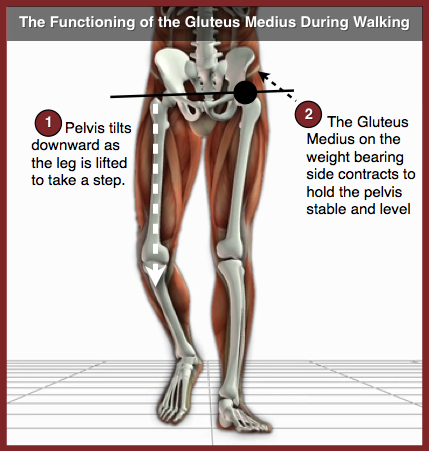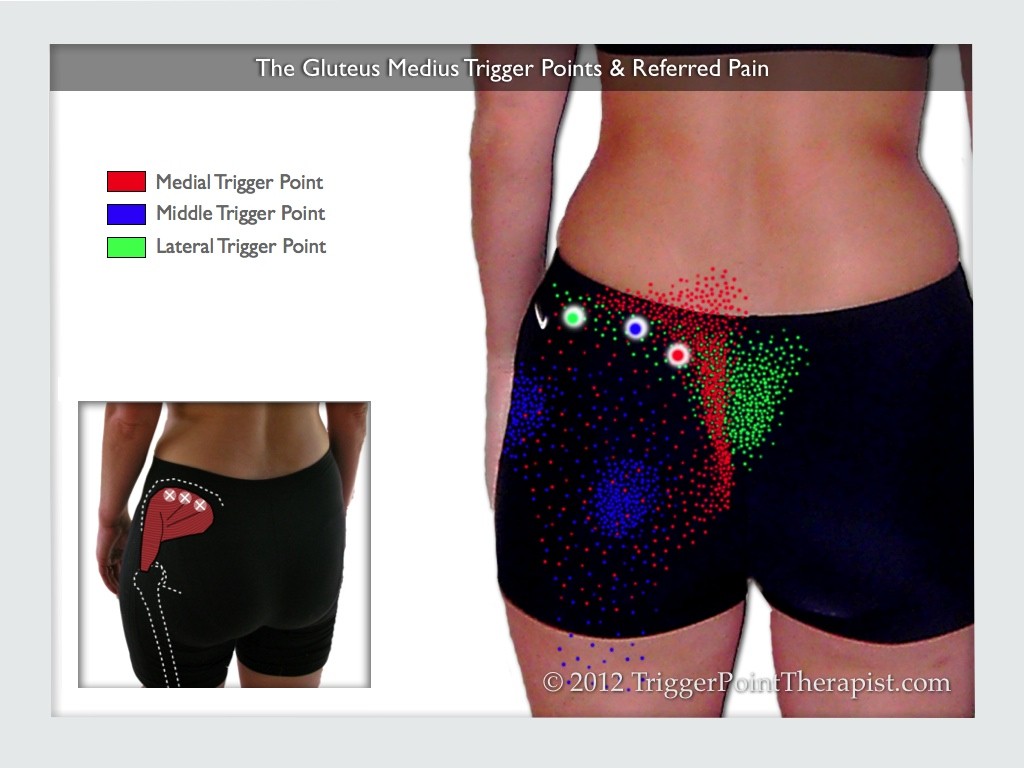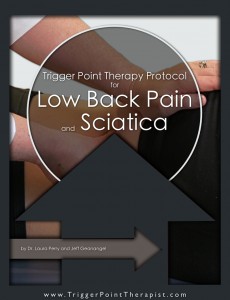Trigger point activity in the Gluteus Medius muscle is a critical player in the majority of low back pain complaints that I see. Dr. Travell, the founder of modern Trigger Point Therapy, chose to refer to the Gluteus Medius as the “Lumbago or Low Backache Muscle” because she found it so frequently involved in this particular disorder.
 The Gluteus Medius Muscle
The Gluteus Medius Muscle
The Gluteus Medius acts as a hip abductor, meaning that it raises the leg up to the side of the body. In everyday life, this muscle primarily functions to keep the pelvis level during walking. Specifically, as one raises a leg to step forward with it, the Gluteus Medius on the opposite side contracts to keep the weight of the free leg from tilting the pelvis downward on that side.
The Gluteus Medius muscle is frequently overloaded by activities that require a person to be bent forward and also bent to one side, like shoveling dirt or snow.
The Gluteus Medius Trigger Points
The Gluteus Medius muscle can contain up to three active trigger points, spaced out evenly across the top portion of the muscle:
- The Medial Gluteus Trigger Point is found just to the outside (lateral) of the Posterior Superior Iliac Spine (P.S.I.S) on the pelvic bone, and is by far the most common of the three. (The P.S.I.S. is the bony lump near the S.I. joint that makes the “dimple” above each buttock). This trigger point refers pain along the belt-line, up into the lower lumbar spine region, and typically concentrates strongly around the Sacro-Iliac joint.
- The Middle Gluteus Medius Trigger Point lies a few inches lateral to the medial trigger point, just under the peak (apex) of the Hip Crest. This trigger point refers pain downward into the buttock region and sometimes into the upper posterior thigh region as well.
- The Lateral Gluteus Medius Trigger Point lies near the outside border of the muscle, a few inches lateral to the middle trigger point and near the Anterior Superior Iliac Spine on the front of the pelvis. This trigger point refers pain directly over the sacrum (tailbone) and the S.I. joints. I have yet to see an active lateral gluteus medius trigger point in my practice, but I will still check for it.
Partners in Crime
It is important for the clinical therapist to understand that Gluteus Medius trigger points are almost always seen in conjunction with Quadratus Lumborum trigger points. These two muscle are strong functional synergists, and if a particular activity or posture overloads one of these muscles, it also overloads the other muscle as well. In addition, the referred pain from the Quadratus Lumborum trigger points will frequently activate satellite trigger points in the Gluteus Medius muscle.
Releasing the Gluteus Medius Trigger Points
For all the details on the anatomy and biomechanics of this muscle, the clinical findings for the gluteus medius trigger points, and detailed instruction for locating and releasing these trigger points, please watch this sample video taken from our Trigger Point Therapy DVD / Video for Low Back Pain & Sciatica.
This content is also available as a free booklet for the iPad. View it in the iBookstore here: Trigger Point Therapy for the Gluteus Medius Booklet for iPad
Click on the image below to watch the free Gluteus Medius Trigger Points video on YouTube:
Related Articles:
- Trigger Point Therapy for Low Back Pain; Understanding the Complaint Within the Complaint
- The Quadratus Lumborum Trigger Points: Masters of Low Back Pain
- Gluteus Minimus Trigger Points: A Small Muscle With A Big Mouth
Related Instructional Videos:


